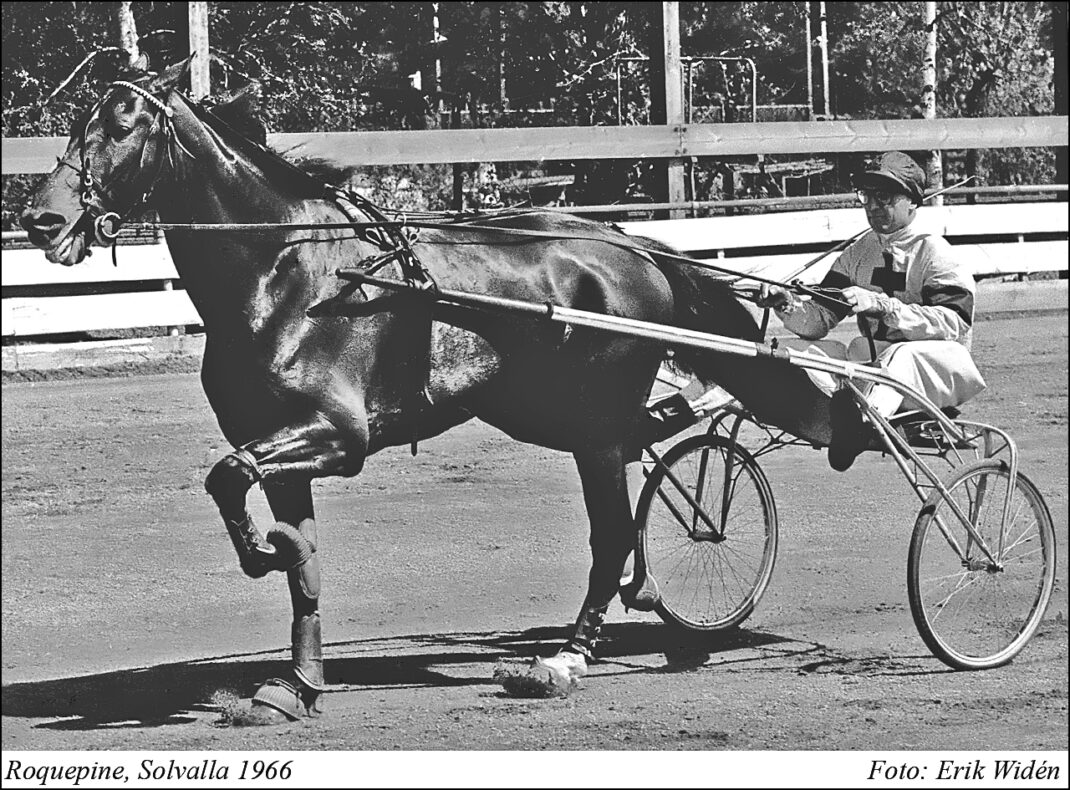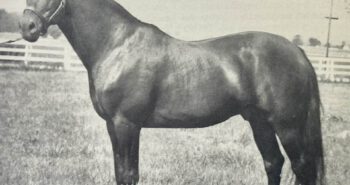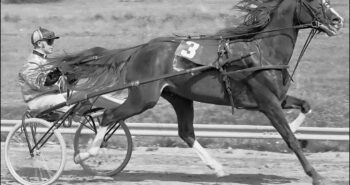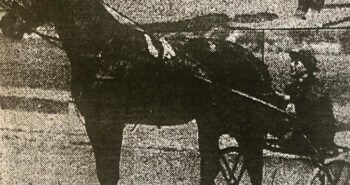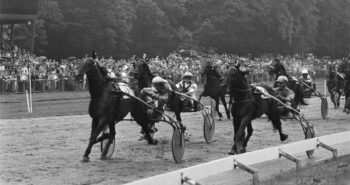She was the undisputed queen, not only of France but the whole world trotting. In fact, she was so superior that she was excluded from the betting in her 1967 Elitlopp elimination! Roquepine won races all over the world, at every track, distance and position. To top it off, she then gave birth to possibly the most influential stallion in French trotting history, Florestan.
Roquepine, bred by Henri Levesque and foaled on April 8, 1961, comes from one of the top maternal families in France. The breeder had high expectations, and for good reason. Several years prior he had identified the diminutive (155 cms/ 15,1 hands) Sa Bourbonnaise as an ideal broodmare and bought two of her daughters, Jalna IV and Glamour II. Sa Bourbonnaise was one of the golden broodmares in the history of French trotting, and also winner of 1944 Criterium des 4 ans, the 1945 Criterium des 5 ans and third in the 1947 Prix d’Amerique. She then quickly proved her worth in the breeding shed. Her third foal, and first son, was Hermes D, by Kairos, who proved a very good stallion from 1957 to 1974. Her fourth foal, the mare Infante II, by Hernani III, was the first French female sub-1.15 (2:00.4) trotter with three top-5 finishes in the Prix d’Amerique, and later produced Sabi Pas, sire of Carioca II.
Talented but temperamental
Levesque did not stress his headstrong filly too much as a youngster and started her career relatively slowly. Not making her debut until she was 3, she did manage a second place in the monte (RUS) Group I-race Prix de Vincennes that year, ridden by Francois Brohier. He reported back to Levesque that the filly didn’t really tolerate a rider and should be switched back to sulky races.
Teaming up with the person he felt ideal to handle his fickle and temperamental filly, Levesque handed the driving reigns over to Jean Rene Gougeon, while training her himself. The next year Roquepine established herself as the dominant horse in the crop, winning the Criterium des 4 ans, Criterium Continental, Prix Octave Douesnel, Prix Guy le Gonidec and Prix Marcel Laurent. By doing so she also made herself the favorite for the upcoming Prix d’Amerique.
Assuming the throne at 5
In the 1966 Prix d’Amerique, after a moderate start, she ended up outside Queronville LB who refused to relinquished the lead. Gougeon and Roquepine just kept on pressuring the leader and Queronville eventually surrendered while Roquepine went on to win in a new track record. She barely managed to hold off a fast-closing Elma, though, who was a very impressive second. Totally dominating both at home and away that year, in France she also picked up wins in Prix de l’Etoile, Prix Doynel de Saint-Quentin, Prix Roederer, Prix Jockey, Prix d’Europe and the Criterium des 5 ans. The wins in the Prix d’Europe and Prix Jockey were only 48 hours apart (!)
A big star at home, her reputation outside of France also skyrocketed at 5. Going to the Elitlopp in May, Roquepine took the easiest of wins. Parking herself outside the Swedish Xanthe in her elimination, Roquepine won comfortably. Interestingly enough she wasn’t the favorite in the final – that was instead the Gerhard Kruger trained Cheer Honey, a daughter of Florican, who finished third. In the final Roquepine again ended up parked outside the leader, this time Quioco, driven by Jean Rene Gougeon’s brother Michel Marcel, and many thought that would be too difficult a task. It wasn’t, though: at the top of the final stretch Roquepine had worn down Quioco and sped away to an easy win, winning in 1.15,3 (2:01.1f).
Roquepine also visited Copenhagen to win The Invitational trot (later known as Copenhagen Cup), and Italy to win the Gran Premio Delle Nazioni. Visiting the US in July she also took part in the 1966 International Trot. There she met another mare in rich form, the Canadian Armbro Flight who took her 50th career win by a neck over a fast closing Roquepine, while Noble Victory finished third, a whopping eight lengths behind the two mares. Opening up a five-length lead at the top of the stretch, Armbro Flight was saved by the finish line when Roquepine came at her. After the race, Jean-Rene Gougeon denied reports he had mistaken the finish line in the race and instead gave credit to Joe O’Brien for opening the five-length lead with a quick burst of speed. “That won the race. We needed 10 more meters”, Gougeon said to media after the race. As Armbro Flight straining a ligament in her left hoof there would be no revenge match in the Challenge Cup the following week. In the end both were scratched as Roquepine also got ill the night before the race.
A few months later, back in the US for the United Nations Trot, Gougeon would not let himself be had by any smart tactical drives from other drives. When Noble Victory went to the lead, he immediately moved up outside. Putting pressure on the American stallion, Gougeon and Roquepine forced their way to the lead with a lap to go and, while Noble Victory faded and finished last, Roquepine held off Speedy Rodney to win comfortably.
Untouchable
In 1967 Henri Levesque wanted to taste Prix d’Amerique glory from the drivers seat and drove Roquepine to a one-length win ahead of her stablemate Oscar RL, who was driven by their trainer Jean-Rene Gougeon. Continuing her complete dominance, Roquepine also picked up wins in the Grand Criterium de Vitesse, the Prix de Bourgogne and the Prix de l’Atlantique in 1967.
But she kept up her road trips, travelling more than a stereotypical busy encyclopedia salesperson to pick up numerous wins around Europe and in the US. In the Elitlopp she was deemed so superior that the Swedes even put her outside the betting in the elimination. Needless to say she won easily ahead of the Italian owned Lansing Hanover, and in the final she has no problems holding off the Italian-trained trio Spin Speed, Lansing Hanover and Short Stop. Roquepine was popular in Italy after numerous trips to the country. In 1967 she picked up wins in the Lotteria, Gran Premio Freccia d’Europa, Gran Premio Costa Azzurra and others.
In fairness, Roquepine was probably even more popular abroad than at home. She was not always very friendly and reputedly a handful. She did not have the charm and charisma of Ozo and that, coupled with her sometimes unpleasant disposition, meant she was not loved like the aforementioned filly by the French public. She was, however, described as a dream trotter and on her foreign trips she rarely lost, usually winning with ease. Roquepine often had to do everything herself, being parked outside the leader or going third over if necessary. Though she couldn’t match some US-bred trotters, Roquepine was relatively fast out of the gate and could also take the lead at times. Gate speed is not important over longer distances in France, but Roquepine show numerous times abroad she could leave quickly. According to Jean-Rene Gougeon, the queen had no weaknesses.
Her win in the 1967 International Trot was controversial, though. Roquepine took the lead and with Oscar RL on the outside, the French duo slowed the pace down so much that many Americans felt it violated their unwritten rule about certain speed, the elite group that competed in the this group never went as slow as this race with Roquepine winning in an embarrassingly slow 2:46.1 (1.21,1) over 2011 meters (1 1/4 mile) – several seconds behind than the second-slowest win in the race’s history. This win caused a lot of resentment and when there was contact between Fresh Yankee and Roquepine, Sanders Russell, driver of Fresh Yankee, lodged the foul claim and contended that Roquepine had drifted out from the rail and knocked his mare into a break just before the mile mark. Jim Dennis, driver of Perfect Freight who was sitting behind Fresh Yankee when the incident happened called it “the worst thing I ever saw when the French mare came out into Fresh Yankee.” Based on this and marks found on Fresh Yankee, the judges disqualified Roquepine. It would be the first time in 31 races that Roquepine finished outside the top two, being 24-6 in her last 30 races prior to the Challenge Cup.
In 1968, Jean-René Gougeon again drove Roquepine in the Prix d’Amerique. Taking her third consecutive win, something only four greats have managed in the race’s history so far, after the race Gougeon cooly stated that “I didn’t need to do anything, she was much better than the rest.” Winning the Prix de l’Atlantique and the Grand Vitesse for a second time, she was still the top trotter at home and she now she spent even more time in Italy, winning Gran Premio Delle Nazioni, Gran Premio Freccia d’Europa and several other top races.
But her dominance was challenged heavily by five-year-olds Tidalium Pelo and Tony M, plus the one year younger Une de Mai. She also won the International Trot, this time avoiding the controversy that dogged her the previous year. Letting the Swedish trotter Kentucky Fibber dictate the pace, Jean-Rene Gougeon instead used Roquepine’s speed in the final stretch to win by one length.
A shadow of her old self
Going into the 1969 Prix d’Amerique there were high hopes that she would be the first – and only – horse to win four straight Prix d’Amerique but several years of competing at the top had started to take its toll and Roquepine could only manage a seventh place. The winner was Upsalin, driven by Louis Sauve – but owned and trained by Henri Levesque who thus “kept it in the family.” In May she was a shadow of her own self in the 1969 Elitlopp and finished last in the final. Realizing she was past her best, Levesque saw no point in Roquepine racing and she was retired later that year.
The super mare had earned her retirement, though: Roquepine’s CV qualifies her as one of the absolute best, if not the very best, trotters of all time. There have been several impressive French trotting queens, but none has won so many different elite races over different racetracks, different distances and with different competitions for three full seasons. Roquepine truly was la reine des reines, the queen of queens.
A controversial decision
Despite her only having 4 foals, Roquepine went on to become an immensely influential broodmare – but it started in highly controversial fashion. Levesque was a great believer in the Franco-American cross and wanted to use an American stallion on Roquepine. The decision to breed the French queen to an American stallion created a lot of discussion and controversy, and the French association made it clear no such foal would ever be registered in the French studbook. Levesque, however, stuck by his convictions, and in 1970 the best French mare in history was bred to the best US stallion, Star’s Pride. The following year the colt Florestan was born at Hanover Shoe Farms, where Roquepine was stabled as a broodmare in the US. A good trotter, Florestan would leave a massive legacy at stud and should be considered one of the most, if not the most, influential stallion in French trotting history. Roquepine was then bred to Ayres and taken home to Europe and delivering another colt named Granit, who turned out to be a very good racehorse. Back in France she had two more foals.
The first of these, the mare Hague, by Kerjacques, won the 1978 Prix Marcel Laurent before finishing third in the European Championship for 5-year-olds. The following year she was second in the Prix de la Cote d’Azur. Hague’s daughter Formose won several group 1-races in around the turn of the century was finished fifth in the 1998 Criterium des 5 ans. Formose in turned gave birth to the good stallion Opium, winner of the 2007 Prix Doynel de Saint-Quentin and 2009 Grand Prix du Conseil Municipal. Roquepine’s fourth and last foal was Ile Marie by Fandango, a mare who was second in the 1980 Group 3-race Prix de Dinan.
Roquepine passed away in 1974, only 13 years old, after birth complications from foaling her daughter Ile Marie.
roquepine
Bay filly born in Manche, France on Apr 8, 1961. Died in Manche, France in 1974.
Atus II – Jalna IV (Kairos)
1.15,1 (2:00.4f) – € 718,608
Breeder: Henri Levesque
Owner: Henri Levesque
Trainers: Henri Levesque and Jean Rene Gougeon
Drivers: Francois Brohier, Henri Levesque and Jean Rene Gougeon
Groom: –

